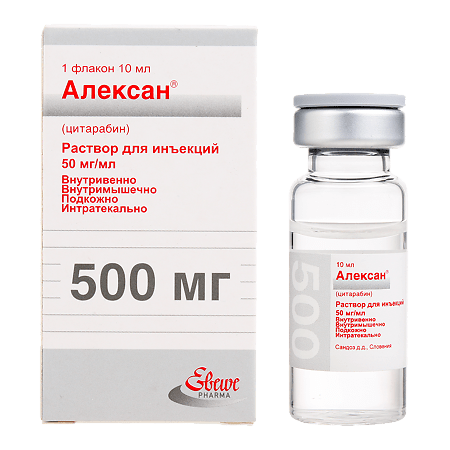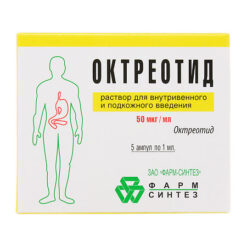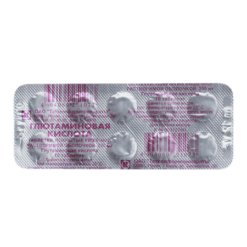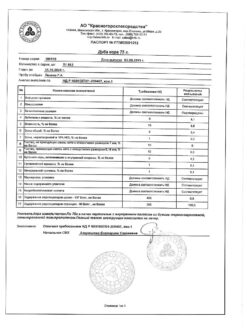No products in the cart.
Alexan, 50 mg/ml 20 ml
€1.00
Out of stock
(E-mail when Stock is available)
Description
The active ingredient of Aleksan® is cytarabine.
Citarabine belongs to the group of pyrimidine metabolites and inhibits DNA synthesis in the cell, mainly in S-phase of the cell cycle. Antileukemic activity of the drug is acquired as a result of phosphorylation into arabinosyl cytosine triphosphate (Ara-CTP), which competitively inhibits DNA polymerase.
DNA synthesis is also inhibited by the incorporation of cytarabine into DNA. The cytostatic effect is dose-dependent.
There are several known mechanisms for the development of resistance to cytarabine: inhibition of membrane transport, deficiency of phosphorylating enzymes, increased activity of inactivating enzymes, reduced affinity of DNA polymerase.
Maintaining a high intracellular concentration of Ara-CTF is crucial for the development of cytotoxic effects.
Indications
Indications
High-dose cytarabine therapy:
Active ingredient
Active ingredient
Composition
Composition
1 ml of 50 mg/ml solution contains::
The active ingredients:
Citarabine 50.00 mg;
Excipients:
Sodium lactate 60 % solution 10.40 mg
Lactic acid (pH regulator) 0.045 mg
Water for injection to 1 ml.
How to take, the dosage
How to take, the dosage
The regimen and method of administration varies with different chemotherapy regimens.
The use of Alexan® is only possible in specialized clinics under medical supervision. Alexan® is not active when administered orally.
The Alexan® drug may be used both in monotherapy and in combination with cytostatics and, in some cases, glucocorticosteroids.
The drug Alexan® may be administered intravenously (bolus or drip), subcutaneously, intramuscularly (usually used only for maintenance of remission therapy), and intrathecally.
The average daily dose is 100-200 mg/m2. For elderly patients or those with decreased hematopoietic reserves, the daily dose should not exceed 50-70 mg/m2.
Induction of remission in acute leukemia: in combination with other antitumor drugs – 100 mg/m2/day as a continuous rapid or slow intravenous infusion for 5-10 days or intravenously every 12 hours for 7 consecutive days. A total of 4-7 treatment courses are carried out. The intervals between courses are at least 14 days.
High-dose therapy: high-dose therapy in treatment of leukemia with poor prognosis, as well as of refractory leukemia and relapses is carried out with the use of Aleksan® at a dose of 2-3 g/m2 of body surface in the form of intravenous infusion lasting 1-3 hours, with 12-hour intervals, for 4-6 days as monotherapy or in combination with other antitumor drugs.
Intrathecal therapy (treatment of leukemic lesions of the central nervous system): In acute leukemia the dose of Alexan® is 5-75 mg/m2. The frequency of administration may vary from once a day for 4 days to once every 4 days. Most commonly, cytarabine is administered at 30 mg/m2 of body surface every 4 days until normalization of parameters, followed by another additional administration. However, the dose and intervals between injections depend on the clinical situation. Due to the fact that the dosage and regimen of Alexan® depend on tailored polychemotherapy regimens, specific literature should be consulted in each individual case.
In cases of renal and hepatic impairment, Alexan® should be used with caution and the dose should be reduced if necessary, especially in patients with significant hepatic and renal impairment.
Citarabine is excreted by hemodialysis. It is not recommended to use the drug immediately before and immediately after a dialysis session.
In elderly patients (over 60 years of age), high-dose therapy may be used only after careful assessment of the benefit/risk ratio.
Preparation of solution for infusion
The Alexan® drug in the required dose is diluted in 0.9% sodium chloride solution or in 5% dextrose solution. The concentration of cytarabine should not exceed 100 mg/ml.
In intrathecal administration of Alexan®, 0.9% sodium chloride solution or 5% dextrose solution may be used. Solvents containing preservatives should not be used.
It is recommended that 5-8 ml of cerebrospinal fluid be taken first, mixed with the solution for injection in the syringe, and then the resulting solution should be slowly injected back.
The solution should be drawn from the bottle immediately prior to use.
Please only use freshly prepared clear solutions and only once!
Interaction
Interaction
Should not be mixed in the same syringe or dropper with other drugs: Pharmaceutically incompatible with heparin, insulin, methotrexate, fluorouracil, oxacillin, benzylpenicillin, methylprednisolone.
The combined use with other anti-tumor myelosuppressive drugs or radiation therapy increases the cytotoxic as well as immunosuppressive activity of these drugs.
In patients receiving chemotherapy including vincristine, prednisolone and cyclophosphamide with cytarabine or procarbazine, the equilibrium plasma concentration of digoxin is reversibly reduced (impaired absorption due to toxic effects on intestinal mucosa) and renal excretion of the glycoside is reduced. The use of digitoxin, whose equilibrium plasma concentration does not change, can be considered an alternative for such patients. In vitro studies of interaction between gentamicin and cytarabine revealed the existence of antagonism, due to which the sensitivity of Klebsiella pneumoniae strains to gentamicin may decrease. There may be a decrease in the effectiveness of fluorocytosine when used concomitantly with cytarabine.
Immunosuppressants (azathioprine, chlorambucil, glucocorticosteroids, cyclophosphamide, cyclosporine, mercaptopurine, tacrolimus) increase the risk of infectious complications.
Killed viral vaccines – due to suppression of normal defense mechanisms by cytarabine, decreased antibody formation is possible.
Live virus vaccines – due to suppression of normal defense mechanisms by cytarabine, viral replication may be potentiated, side effects may be increased, and antibody formation may be reduced.
Special Instructions
Special Instructions
The use of the drug Aleksan® should be carried out under the supervision of a qualified physician experienced in working with antitumor chemotherapy drugs and only under hospital conditions. Aleksan® can be used both as monotherapy and in combination with other antitumor drugs. The dose and regimen of the drug are chosen individually. In case of combined therapy it is necessary to take into account cumulative myelosuppressive effect of all drugs included into the scheme of treatment.
When working with the drug Alexan® care must be taken. The drug should be diluted under aseptic conditions in a specially designated room. This should be done by trained personnel. All measures should be taken to prevent contact of the cytarabine solution with skin and mucous membranes, in particular, protective clothing (gown, cap, mask, glasses and disposable gloves) should be worn. If citarabine comes into contact with the skin or mucous membranes, you should wash thoroughly with soap and water or (eyes) with plenty of water. Cytarabine strongly suppresses bone marrow function. Therapy with Alexan® should be started with caution in patients with existing myelosuppression. Clinical blood count (daily during induction therapy), uric acid concentration in plasma, function of bone marrow, liver, kidneys, central nervous system, lungs should be controlled regularly. If platelets fall below 50000/mm3 or polymorphonuclear granulocytes fall below 1000/mm3, the treatment regimen should be suspended or changed. Peripheral blood platelet counts may continue to fall after drug withdrawal and reach a minimum level after 12-24 days. If indicated, therapy may be resumed when there are clear signs of hematopoiesis recovery based on the results of bone marrow examination.
We should keep in mind that complications such as bleeding (secondary to thrombocytopenia) and severe infection (secondary to granulocytopenia) may develop.
There have been reports of severe CNS, gastrointestinal and pulmonary toxicity (different from that of standard cytarabine therapy), sometimes with lethal outcome. Reversible damage of the cornea of the eye is possible; impairment of brain function, especially of the cerebellum, which are usually reversible, drowsiness, convulsions; severe gastrointestinal ulcers, including cystic pneumatosis of the intestine, which may lead to peritonitis; sepsis, liver abscess, pulmonary edema.
The occurrence of peripheral motor and sensory neuropathy has been reported after coadministration of high doses of cytarabine, daunorubicin, and asparaginase in adult patients with acute non lymphoblastic leukemia. Therefore, caution should be exercised when using high-dose cytarabine and timely dose adjustments should be made to avoid irreversible neurological disorders. There have been reports of delayed progressive ascending paralysis resulting in death in children with acute myeloleukemia after intrathecal and intravenous administration of cytarabine in usual doses in combination with other drugs.
In patients who have previously received treatment with CNS-damaging effects, such as intrathecal chemotherapy or radiation therapy, the risk of neurotoxicity increases with high doses of cytarabine. When cytarabine is administered rapidly intravenously, nausea and vomiting often occur within hours of administration. It is possible to reduce the incidence and severity of these side effects when using the drug by infusion. The literature describes cases of peritonitis and colitis with a positive test for occult blood in combination with neutropenia and thrombocytopenia in patients when using conventional doses of cytarabine in combination with other drugs. Patients have been successfully treated without surgery. There are reports of the occurrence of cardiomyopathy (including fatal) when using high-dose cytarabine in combination with cyclophosphamide. In case of cytarabine syndrome the use of Aleksan® should be stopped and treatment with glucocorticosteroids should be started. If steroid therapy is effective, treatment with cytarabine may be continued.
In order to prevent hemorrhagic conjunctivitis, local use of glucocorticosteroids is recommended.
Caution should be exercised when using the drug in patients with impaired hepatic and renal function.
High-dose therapy and intrathecal therapy should not use solutions containing benzyl alcohol.
As with other anticancer agents, the drug Alexan® may cause hyperuricemia due to rapid decay of tumor cells. Prevention of hyperuricemia is recommended in patients with a high blast cell count or large tumor masses (for example, in non-Hodgkin’s lymphoma): provide allopurinol and adequate fluid intake.
Inoculation of patients receiving therapy with Alexan® should be performed with extreme caution, after careful evaluation of hematologic status and with the consent of the physician administering the cytarabine therapy. The interval between the end of immunosuppressive therapy and vaccination depends on the type of immunosuppressant, underlying disease, and other factors and varies from 3 months to 1 year. Cytarabine is eliminated from the body by hemodialysis. Therefore, patients on dialysis should not be given Alexan® immediately before and during dialysis.
Women and men as well as their sexual partners should use reliable contraception during treatment and for 6 months after completion.
Impact on driving and operating machinery
Patients receiving chemotherapy may have impaired ability to drive and operate machinery, so if possible, they should refrain from engaging in potentially dangerous activities that require increased concentration and quick psychomotor reactions.
Contraindications
Contraindications
With caution
Patients with hepatic and/or renal impairment (due to increased risk of side effects, especially with high-dose therapy), drug-induced suppression of hematopoiesis, bone marrow infiltration with tumor cells, acute viral infections (including varicella and pox).viral (including chicken pox, shingles), fungal or bacterial nature (risk of severe complications and generalization of the process), diseases in which there is an increased risk of hyperuricemia (gout or urate nephrolithiasis). During treatment with cytarabine, as well as the use of other immune-suppressing drugs, vaccination with live vaccines should be avoided. In patients over 60 years of age, the use of high doses of cytarabine is possible after careful assessment of the benefit/risk ratio.
Side effects
Side effects
Overdose
Overdose
Symptoms: vomiting, diarrhea, marked suppression of bone marrow function, bleeding, development of infection, symptoms of neurotoxicity (impaired consciousness, motor disorders, seizures, cognitive disorders).
Treatment: there is no specific antidote. If an overdose occurred, symptomatic therapy (hemotransfusion) should be carried out. In case of severe overdose, after intrathecal administration, spinal fluid should be immediately replaced with isotonic saline solution. Cytarabine is excreted by hemodialysis. However, there is no information on the effectiveness of hemodialysis for cytarabine overdose.
Additional information
| Shelf life | 2 years. |
|---|---|
| Conditions of storage | Store in the dark place at a temperature not exceeding 25°C. Store out of the reach of children. |
| Manufacturer | Fareva Untereh GmbH, Austria |
| Medication form | solution for injection |
| Brand | Fareva Untereh GmbH |
Related products
Buy Alexan, 50 mg/ml 20 ml with delivery to USA, UK, Europe and over 120 other countries.












